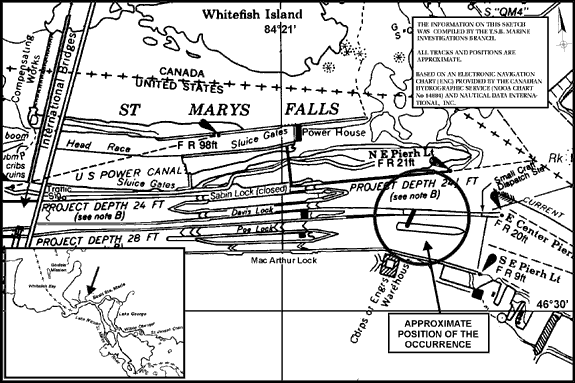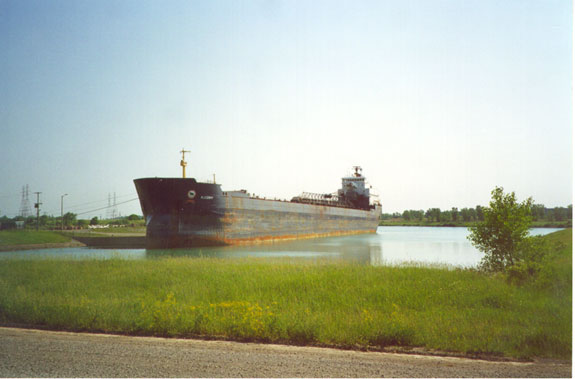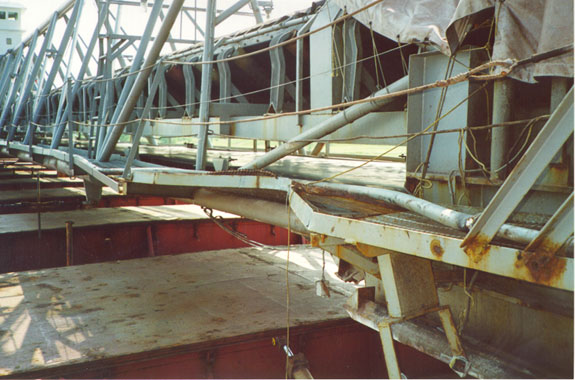Striking of a dock with an unloading boom
the self-unloading bulk carrier "ALGOBAY"
Poe Lock, Sault Ste. Marie, Michigan, United States
The Transportation Safety Board of Canada (TSB) investigated this occurrence for the purpose of advancing transportation safety. It is not the function of the Board to assign fault or determine civil or criminal liability. This report is not created for use in the context of legal, disciplinary or other proceedings. See Ownership and use of content. Masculine pronouns and position titles may be used to signify all genders to comply with the Canadian Transportation Accident Investigation and Safety Board Act (S.C. 1989, c. 3).
Summary
On 09 June 1999, the Canadian-registered self-unloading bulk carrier "ALGOBAY" was exiting the Poe Lock downbound, at Sault Ste. Marie, Michigan. As the vessel passed the eastern approach wall, the unloading boom was raised to correct a one and one-half degree list to port. The boom swung out of control to port and knocked down five light standards on the approach wharf. Structural damage to the boom was minor; however, the hydraulic slewing system was extensively damaged. There were no injuries or pollution as a result of the occurrence.
Factual information
| Name | "ALGOBAY" |
|---|---|
| Port of registry | Sault Ste. Marie, Ontario |
| Flag | Canada |
| Official number | 372053 |
| Type | Self-unloading Bulk Carrier |
| Gross TonsFootnote 1 | 21,891 |
| Length | 222.51 m |
| Draught | Forward: 8.05 m Aft: 8.11 m |
| Built | 1978, Collingwood, Ontario |
| Propulsion | Two 10-cylinder Crossley Pielstick (10PC2-3V-400) diesel engines; 7870 kW total. Single controllable-pitch propeller and bow thruster. |
| Number of Crew | 24 |
| Registered owner | Algoma Central Marine Sault Ste. Marie, Ontario |
History of the voyage
The "ALGOBAY" departed Superior, Wisconsin, at 1710 eastern daylight time, 07 June 1999, with a cargo of 26,137 tons of coal.Footnote 2 On the morning following departure, as the vessel crossed Lake Superior, the chief engineer, with the authorization of the master and shore management, shut down the port main engine for unscheduled repairs.
At 1745, the vessel advised Vessel Traffic Services (VTS) that the passage through the locks at Sault Ste. Marie and the St. Marys River would have to be conducted with one engine. Permission was granted by the United States Coast Guard (USCG) and Sault Ste. Marie harbour master.
Before arriving at the Sault locks, the vessel had developed a one and one-half degree list to port. Concerned with low water levels in the St. Marys River and the 10 cm of extra draught the list would have created, the master ordered the second officer to lift the unloading boom and slew it to starboard as the vessel departed Poe Lock at 0225 on June 9. In doing this, it was hoped that ballast water remaining on board in the No. 3 port ballast tank would be displaced to starboard and the list corrected. As the boom was being lifted from its saddle, it began swinging to port.
Despite attempts by the second officer to check its movement with the slewing controls, the boom accelerated outwards until it contacted the front of the accommodation at an angle of 90 degrees to the vessel.
At the time of the occurrence, the vessel was travelling at four knots, approximately 50 m from the lower approach wall to Poe Lock. As the vessel continued forward, the boom made contact with five light standards. Upon seeing the boom swing fully to port, the master immediately put the engine to full astern. The single engine, running full astern, was overloaded and the watchkeeping engineer informed the master that he would have to reduce power.
In an attempt to prevent further damage to the boom and wharf, the second officer topped up the boom until he was prevented from lifting further by the accommodation structure. The master ordered the stern and both bow anchors dropped to help arrest the vessel's forward movement and to prevent it from swinging towards other vessels moored at the adjacent USCG base.
Once the vessel was stopped, and the boom recovered, the "ALGOBAY" proceeded to tie up on the lower wall of the MacArthur Lock with the assistance of two tugs.
Damage to the Vessel and Dock
Five light standards on the approach wharf were knocked down and damaged.
The unloading boom suffered extensive damage to its port forward and starboard after slewing cylinders when air trapped in the hydraulic slewing rams compressed and fractured the cylinders. The unloading hopper was damaged, as were the starboard catwalk and lower longitudinal, which were set in at the point of contact with the light standards.
Voyage Repairs
During the ballast voyage to Superior, it had been discovered that the No. 1 cylinder head on the port main engine was leaking cooling water from a jumper between the block and cylinder head. Not wanting to delay the vessel's departure from Superior by carrying out repairs there, the chief engineer and master agreed that the port main engine would be shut down after departure to make the repair while the vessel was under way. It was anticipated that the repairs would take approximately 12 hours.
At 0800 on June 8 the repairs were begun; however, while removing the cylinder head from the engine, it was discovered that a cylinder head stud was broken and would have to be replaced. The chief engineer, who had previous experience with this type of repair, informed the master of the situation and revised his estimated completion time upwards to 24 hours. As the work would be conducted near the running starboard main engine, the chief engineer suggested that the vessel be stopped in Lake Superior for the duration of the repair. In consultation with the master and chief engineer, the company engineering superintendent decided that the vessel should proceed towards Sault Ste. Marie in case further shore support was needed for the repairs. During the previous sailing season, the vessel had operated for several months on one engine, including during passages through the American locks at Sault Ste. Marie.
On the morning the main engine repairs were begun, the head tunnelman asked for and received permission from the chief engineer to change the oil in the hydraulic slewing system of the cargo unloading boom. Due to the relatively short voyages undertaken by the vessel since the beginning of the 1999 season, this scheduled preventative maintenance procedure was overdue. During the longer trip from Superior, Wisconsin, to Nanticoke, Ontario, the cargo unloading boom would not be used and this period was adequate to complete the maintenance.
After the deck department had transferred cargo to correct a slight port list, and had run "spillage," the head and assistant tunnelmen drained the hydraulic oil from the slewing system and proceeded to clean the hydraulic tank. It is reported that the chief engineer opened the breaker in the engine-room and tagged it as being unavailable for service; however, the bridge was not informed of the maintenance work being conducted.
At 2000 the head tunnelman reported to the chief engineer that he had finished draining and cleaning the hydraulic system. The chief engineer indicated that, because the head tunnelman was unfamiliar with the procedure to bleed the air from the hydraulic system, he decided to wait until daylight the following morning. The chief engineer, assuming that the system had been refilled with oil, returned to the engine-room, removed the tag from the slewing system breaker and turned it back on. The oil, however, had not been refilled and the slewing system was still unserviceable.
The unloading boom topping lift system was actuated directly by an electric motor, and operated independently of the hydraulic slewing system. Although the slewing system was fitted with an interlock that prevented the slewing pump from starting without oil in the hydraulic tank, the interlock was not tied into the topping lift controls.
Engine-Room Staff Experience
At the time of the occurrence, the chief engineer, third engineer, and one mechanical assistant were the only regular engine-room staff members on board. All other staff members were "relieving" crew, unfamiliar with the vessel. The head tunnelman was a vacation relief and, although he had experience on other self-unloaders, he was relatively unfamiliar with the unloading equipment on the "ALGOBAY".
On-board Procedures
Although a video on electrical "tag-out" procedures was available on board, the head tunnelman had not viewed it when he came on board three trips before the occurrence trip. Binders containing "tag-out" procedures pursuant to the International Safety Management (ISM) Code were on board, but were stored on the bridge and in the master's and the chief engineer's cabins, and not readily available for general reference by the crew.
Notwithstanding company standing orders requiring the deck and engine-room departments to inform each other of machinery being taken out of service, the deck and engine-room departments did not regularly exchange information concerning routine maintenance that could affect the operation of the vessel. As well, within the engine-room, the tunnelmen reported directly to the chief engineer and did not provide information on their activities to the watchkeeping engineers.
No formal procedures were in place for the operation of the unloading boom. Unless electrical power was needed to run the main unloading belts, the engine-room was not informed when the boom was to be raised or slewed. No pre-start checklist was used to verify the readiness of the unloading boom for service (in particular the oil level in the hydraulic slewing system). The unloading system was equipped with two "lockout" keys controlling the unloading belt drive motors and the slewing/hoisting system respectively. It was the practice to leave these keys in their respective key switches in the unloading control room when the system was not in use.
Analysis
On-board Procedures
Through the application of the ISM Code, shipping companies can minimize the number of human performance decisions which may lead to an accident. With the provision of adequate, accessible policies and procedures, a ship's crew is better equipped to make day-to-day operational decisions. The company safety management procedures for lockout of equipment required that each employee attach his own lock to the lockout device. Additionally, the unloading equipment was equipped with keyed switches, which were left in the "on" position when not in use. The head tunnelman was supervising the maintenance of the hydraulic slewing system; however, he had not been required to watch the available instructional video, nor was he aware of the procedure binders.
Notwithstanding the company's lockout procedure, the tunnelman and the assistant tunnelman were not fully aware of the status of the power supply to the boom, nor were they in control of the lockout device used. As a result, the boom power was restored without their knowledge and without the maintenance having been completed.
The second officer was familiar with the controls and operation of the unloading boom, having operated it many times in the past. However, formal procedures, such as checking the oil level, making a walk-around inspection, or communicating with the engineer on watch, were not in place to help ensure that the topping lift and slewing systems were serviceable before operation. As a result, the boom was topped up before the slewing system operation was verified, resulting in the uncontrolled movement of the boom to port.
Communications
Communications between the various shipboard departments is vital for the safe operation of modern complex vessels. On board the "ALGOBAY" it was not the practice for the deck and engine-room departments to inform each other of work being conducted on a day-to-day basis. As a result, the master was unaware that the unloading boom hydraulic slewing system was unserviceable when he requested the second officer to shift the boom in an attempt to correct the vessel's port list.
Engine-Room Workload
With one main engine unserviceable, the chief engineer's priority was to complete the engine repair as soon as possible. He was hampered in doing so by inexperienced relief engine-room staff who required constant supervision while working on the engine. Even though he gave permission for the relatively inexperienced head tunnelman to change the oil in the unloading boom hydraulic slewing system, he was unable to provide supervision due to the demands placed upon him by the main engine repair. As a result, he was unaware that the unloading boom slewing system had not been refilled with oil when he removed the lockout tag on the slewing system power supply.
Unloading Boom Control System
The design of the unloading boom controls incorporated an electrical interlock that prevented the hydraulic pump for the slewing system from starting if inadequate oil was available in the header tank. However, the interlock did not interfere with the operation of the electric motor used to top up the boom. Therefore, the second officer, who did not know that the slewing system was unserviceable, was able to top up the boom from its saddle. When the boom was raised, no slewing control was available, and it rapidly swung out of control to port (in the direction of the ship's list) until its movement was arrested by the ship's accommodation.
Vessel's Stopping Ability
Although the "ALGOBAY" had sailed on one engine without incident for several months during the previous season, vessels are designed for optimal manoeuvrability when full power is available from the main propulsion system. When the propeller was put to full astern, the starboard main engine provided about 50 per cent of the total power normally available, which reduced the vessel's ability to stop.
Findings
- The port main engine had to be shut down for 24 hours to repair a broken cylinder head stud and cooling-water leak, resulting in the vessel proceeding towards Nanticoke on one engine.
- The chief engineer, third engineer, and one mechanical assistant were the only regular engine-room staff on board and, as a result, the chief engineer had to closely supervise the engine repairs.
- Procedures to ensure that the deck and engine-room departments exchanged information were not being followed at the time of the occurrence.
- The engineering staff conducted preventative maintenance on the hydraulic slewing system of the unloading boom without the deck department having been informed.
- The company lockout procedures for machinery maintenance were not followed.
- The tunnelmen did not refill the hydraulic slewing system before finishing work for the day.
- The chief engineer assumed multiple responsibilities occasioned by the engine repairs and hydraulic maintenance and, assuming that the hydraulic slewing system had been re-filled with oil, removed the lockout from the slewing system power supply.
- There were no formal operating procedures for the cargo boom that would help ensure that the hydraulic slewing system was serviceable.
- The slewing system low oil level interlock was not connected to the topping lift controls to prevent the boom from being topped up without adequate oil in the hydraulic slewing system.
- When the boom was raised, the vessel's list caused the boom to swing, uncontrolled, to port. Air trapped in the hydraulic slewing rams compressed and fractured the cylinders.
- The vessel's stopping ability was reduced as a result of the port main engine being unavailable.
- Before the vessel could be brought to a stop, the boom knocked down five light standards on the wharf.
Causes and Contributing Factors
The unloading boom of the "ALGOBAY" swung uncontrollably to port when it was topped up without oil in its hydraulic slewing system. Contributing to the occurrence was: the over-tasking of the chief engineer, due to an unscheduled engine repair; the unfamiliarity of the relief engine-room staff with the vessel and shipboard procedures; inadequate unloading equipment operating procedures; and the design of the hydraulic system, which did not have lockouts to prevent the starting of the topping lift motor if the oil level was low in the slewing system.
Safety action
Action taken
Subsequent to the occurrence, Algoma Central Marine reviewed its operating procedures for self-unloading equipment. As a result, the company has standardized operating procedures across its fleet with the following:
- When the boom and self-unloading equipment are not in use, the main breaker supplying the unloading switchboard is to be left open.
- If crew members are working on or near equipment, then the main breaker is to be padlocked open, as per the company's lockout/tagout procedures.
- The main breaker is to be closed by the engineer on watch, only after receiving orders to do so by the chief engineer, master, or mate on watch.
- The lockout keys in the control room are not to be left in the boom/unloading system when not in use.
- The master key which controls all of the unloading drive motors is to be used only by the chief engineer and kept in his office.
- The slew/hoist key is to be kept in the engine control room and may be retrieved only by the chief engineer or officer of the watch.
- The chief engineer is to keep and maintain marked duplicates for both keys, for emergency use only.
- An interlock has been installed to prevent the boom being hoisted in the event that the slewing system is not functioning.
- The "Boom Operational Procedures" have been amended to ensure that the boom is checked for operational readiness prior to use.
In addition, the company has re-emphasized to the officers and crew of the "ALGOBAY" the importance that open interdepartmental communication plays in the safe operation of the vessel.
This report concludes the Transportation Safety Board's investigation into this occurrence. Consequently, the Board authorized the release of this report on .




